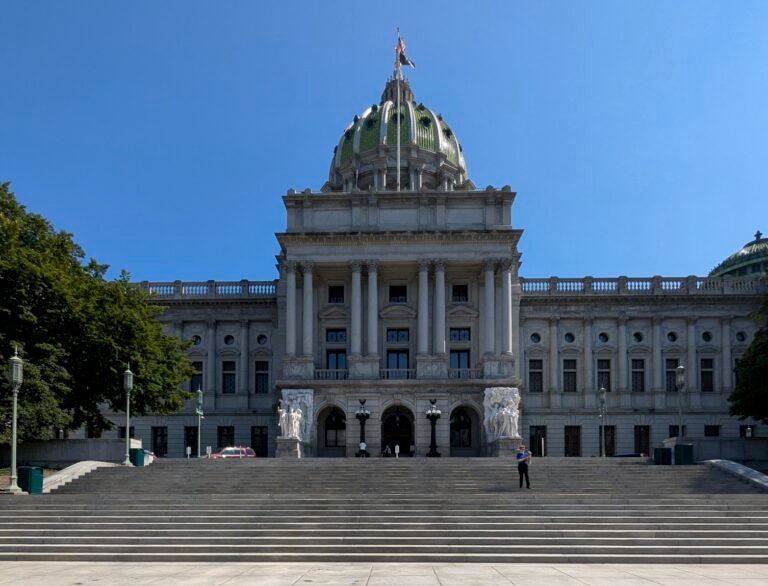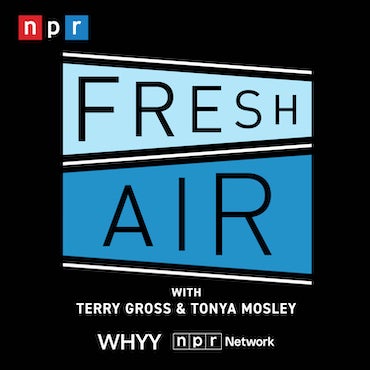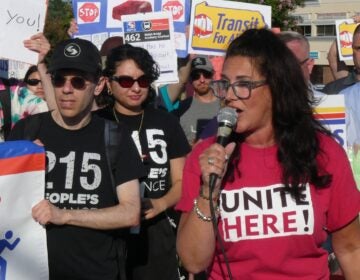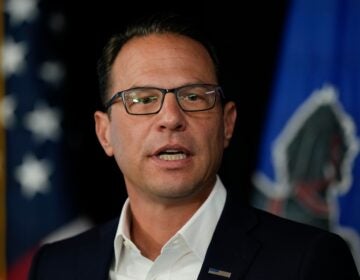Life goes on: Why Pennsylvania lawmakers are in no hurry to make a budget deal nearly two months after the deadline
Thanks to a “unique mix” of characteristics, Pennsylvania keeps running, even without a budget. But that isn’t necessarily a good thing.

The Harrisburg Capitol building on Sept. 5, 2024. (Jeremy Long/WITF)
From Philly and the Pa. suburbs to South Jersey and Delaware, what would you like WHYY News to cover? Let us know!
Pennsylvania lawmakers are now nearly two months behind in passing a state budget, but the commonwealth isn’t grinding to a halt. State employees are still on the job, drivers can still renew their licenses and schools will still open this week.
At the federal level, Congress must pass funding bills to keep agencies open. If they don’t, the government shuts down. That’s also the case in many other states, like New Jersey, which shut down for three days in 2017. That led to the closing of state parks and beaches, as well as images of then-Gov. Chris Christie controversially enjoying an empty beach with his family. In Delaware, the legislature has become known for last-minute, late-night marathons to pass a budget before a shutdown in state services would take effect, potentially causing instant upheaval.
But Pennsylvania works differently and, as the debate rages on about how the state will or will not spend money to rescue SEPTA from its $213 million financial shortfall, the government largely continues to run as normal otherwise.
While the state Constitution requires a budget to be enacted by June 30 each year, the absence of a spending plan does not automatically shutter government operations as most of the core functions of government continue automatically. State parks are still open to the public, prisons continue operating and PennDOT stays in business.
“Pennsylvania can keep muddling through because they have a unique mix of constitutional and statutory exceptions as well as a layer of court rulings that facilitate the continued payment of certain state services,” said Bernie Gallagher, executive director at Keystone Research.
For example, in two lawsuits — Council 13, American Federation of State, County and Municipal Employees v. Casey of 1993 and Council 13, AFSCME v. Commonwealth of Pennsylvania of 2009 — the Pennsylvania Supreme Court ruled that the state had to pay its employees who were already working, even if a budget wasn’t in place. That means they are not furloughed like federal employees. That also means much of the state government continues to operate.
Essential services must continue
State law also authorizes the state to pay for essential services, so called “Ledger 5 expenditures,” such as the completion of infrastructure projects already underway and payments required under federal law like unemployment compensation, Medicaid and Medicare disbursements and other federal aid programs.
And there’s still a flow of money. Although there isn’t a budget, taxes and fees are still being collected, so the state coffers continue to have liquidity that helps pay for government expenses deemed too important to stop.
“There’s obviously a big uptick when personal income taxes are due but, on an otherwise rolling basis, payments are being made,” Gallagher said.
Since most things continue to work, most people don’t even realize that there’s anything even wrong, reducing the pressure on Harrisburg even further, said Sam Chen, a political strategist who worked for former Gov. Tom Corbett, among other prominent Pennsylvania politicians.
“It’s so inside baseball; it’s not an issue that sits on voters’ minds,” Chen told WHYY News. “People like me who are in the business think not having a budget is an awful thing, but nine out of 10 people you talk to aren’t even going to realize that we’re past deadline.”
Budget delays are ‘a common feature’
However, Chen and Gallager both say that it’s regrettable that budget delays have, as Gallager says, “become a common feature in Pennsylvania’s annual budgeting process.” That’s because a lack of danger of a total shutdown provides a pressure valve that, in other states, would force politicians to pass a budget, and there are real impacts from not doing so.
For example, payments to vendors are slowed down or, in some cases, stopped. School districts may be forced to borrow money or dip into reserves for programs that educate students with disabilities and other programs. Nonprofits contracted to provide services like housing for the homeless or foster care stop receiving the aid they need to continue their work.
County and local governments depend on state grants to provide child abuse investigations, mental health care and senior services like Meals on Wheels. Without budget authority, those payments are delayed.
During the 2015–16 budget impasse, Pennsylvania’s county governments bore a heavy financial burden. According to the County Commissioners Association of Pennsylvania, the nine-month delay cost each county an average of $12 million, representing up to 20% of their operating budgets. To continue delivering critical services — such as mental health, children and youth programs and other human services — counties had to tap into reserves, with approximately 70% drawing down savings. Four counties depleted their savings entirely, and 30% resorted to borrowing. On average, counties borrowed about $5.7 million each, incurring bank fees of $16,800 and interest charges of $17,970 per county.
The impasse forced difficult trade-offs. Nearly half of Pennsylvania’s 67 counties delayed payments to service providers and vendors, and postponed capital projects and routine operations. Many imposed hiring freezes and scaled back nonessential travel and training. The economic consequences extended beyond government balance sheets — taxpayers ultimately felt the strain as counties considered local tax increases to recover funds lost to the impasse. Indeed, public pressure and practical necessity pushed some counties to raise property taxes in 2017 to replenish their coffers and restore normal operations.
This year, regional public transportation has become a flashpoint with SEPTA planning to cut 32 routes and raise fares by more than 20% without new state funding. Pittsburgh Regional Transit is warning of service cuts of 35% and fare increases of more than 9% due to lack of state funding.
After the 2015 budget standoff that led to a nine-month delay past the deadline, the Pennsylvania Association of Nonprofit Organizations released a report documenting how much impact that delay had. Nearly 17,100 people saw their services cut or eliminated, while 90 organizations absorbed more than $80 million in delayed or never-received payments. To survive, 135 nonprofits borrowed almost $172 million — half pulled directly from organizational reserves, nearly 40% from bank loans and 8% from vendors willing to wait for payment.
The financial strain rippled out into daily operations. Nonprofits collectively paid back over $531,000 in interest, 88 programs reduced hours or closed entirely and five organizations shuttered for more than two months combined. The human toll was equally stark: the sector lost the equivalent of 382 full-time staff positions through layoffs, furloughs and departures — nearly half of which were never restored. Leadership across organizations reported difficult trade-offs between debt, staff cuts or outright closure, and many frontline workers endured unpaid hours while watching colleagues exit. The crisis eroded morale and, in some cases, permanently weakened organizations that never fully recovered.
Local and state politicians and others have been warning that cuts to SEPTA could have a huge negative impact on the commonwealth’s economy, but Gallagher points out that a sudden stoppage of other payments would also come with negatives, and then there’s the possible downgrades in credit rating.
“The state is an economic engine,” he said. “And when it stalls, the first to be impacted are schools, counties and the many private businesses that do work with the government.”

Get daily updates from WHYY News!
WHYY is your source for fact-based, in-depth journalism and information. As a nonprofit organization, we rely on financial support from readers like you. Please give today.







